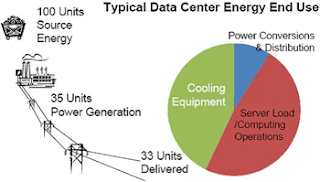Data centers can consume up to 100 times more energy than a standard office building. Often, less than 15% of original source energy is used for the information technology equipment within a data center.
Figure 1 below outlines typical data center energy consumption ratios.
Figure 1: Energy entering the data center is broken into consumption areas such as server load and computing operations, cooling equipment, and power conversion and distribution. Courtesy of DOE Industrial Technologies Program
Data center energy consumption doubled from 2000 to 2006, reaching more than 60 billion kilowatt hours per year. That number could double again by 2011. The Environmental Protection Agency (EPA) prepared Figure 2 below to outline data center energy consumption from 2000 through 2006 with multiple scenarios depicting continued growth through 2011.
Figure 2: EPA-prepared chart shows historical data center energy consumption with several future energy use projections. Courtesy of EPA
The Historical Trends Scenario line depicts data center energy consumption growth through 2011 if historical usage and technology trends continue, reaching just over 120 billion kilowatt hours of energy consumption.
The Current Efficiency Trends Scenario line depicts data center energy consumption growth based on current energy efficiency technology standards and best practices, reaching just under 110 billion kilowatt hours of energy consumption.
The Improved Operation Scenario includes several energy-saving measures such as eliminating unused servers, moderately adopting energy-efficient servers, and improving infrastructure energy efficiency by 30% through airflow management. The result reaches just over 80 billion kilowatt hours of energy consumption.
The Best Practice Scenario is the first to show a drop in data center energy consumption in 2011 compared to 2006 levels. This scenario includes energy-saving measures such as moderate consolidation of data centers, aggressive adoption of energy-efficient servers, and use of improved fans, chillers, and free cooling. The result reaches just under 40 billion kilowatt hours of energy consumption.
The State of the Art Scenario demonstrates the most drastic data center energy consumption reduction. The scenario includes all changes within the Best Practice Scenario and adds power management applications, liquid cooling, and combined heat and power. The result reaches just over 30 billion kilowatt hours of energy consumption.



